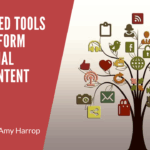 Every author has had one.
Every author has had one.
A dry spell where no matter what you do you just can’t seem to come up with a new idea for an awesome book.
If you’ve ever had a moment when you’ve dipped into your well of inspiration and come up empty, there’s a simple idea that can open up a whole new world of possibility for your writing career.
Self-publishing public domain content.
If you’ve never heard of it, it’s akin to recycling or upcycling old literary works. It involves making content that was published many years ago into something that’s fresh and new for today’s readers.
If you’ve run out of new ideas for your self-published books, maybe it’s time to think about getting into the business of making old things new.
What is public domain content?
They say in life, nothing lasts forever, and that includes the exclusivity that authors have for their published work. After a certain number of years have passed since initial publication, the copyright for a book expires and it’s open season. Other authors and publishers are free to repurpose and use the content.
While it depends on factors such as when the book was published and in which country, just about every book eventually falls into the realm of public domain content.
This offers a tremendous opportunity for self-published authors, because all public domain works are free to be used and altered to create unique offers.
You get the chance to take an original and create a spin off.
You can repurpose public domain content in many different ways.
- You can present the content in a different format (audio, video, etc.).
- You can publish quotes from your chosen books (Pinterest, Twitter, etc.).
- You can put an original spin on an old story (put characters from a story set in a different era into a modern-day setting).
- You can add value to original work (change the book cover or include worksheets).
The possibilities are truly endless.
The best part about it is that you have broad creative scope and no one can sue you or claim copywrite infringement because the piece of content is free to use by anyone.
If you take a moment for that to really sink in, you’ll start getting excited about the huge pool of potential that self-publishing public domain content has for creative authors.
Each year hundreds of books see their copyrights expire and they join hundreds of thousands of books that are available and ripe for revamping and publishing as books based on public domain content.
Ways to Profit from Public Domain Content
If you’re not sure where to start with self-publishing public domain content, here are a few ideas that are sure to get your juices flowing. These simple but effective methods allow you to take previously published titles and release them to an audience in brand new and creative ways.
- Turn printed books into digital offers.
One of the fastest and easiest ways for you to transform a piece of public domain content and release it to a new audience is by taking old printed books and converting them into a digital format.
Because every single book that entering the pubic domain space in 2019 was originally only available in print format (published 50 or more years ago), this is a no-brainer step that can get you sales and exposure without doing a whole lot of work to change the original offer.
There are countless books available online that were formerly only available in hardcopy print format.
There are two ways to go about self-publishing these types of books.
- Create an entire new digital formatted version.
- Scan the pages of the existing book into digital format.
- Add illustrations.
Are you ultra-creative or have an artistic streak?
Another simple way to enhance a piece of public domain content and produce a book that is unique to you is by adding illustrations to the original work before self-publishing.
Images are content too. So, if you can find a way to republish an existing story but make it much more interesting with the generous use of highly complementary illustrations, you may have a new hit on your hands.
There is huge opportunity for this application in the children’s literature niche.
You can take any public domain children’s story or poem, create images that complement each one, and you will have created an entirely new offer.
If you aren’t great at art and drawing, you can consider collaborating with an experienced artist to co-author a children’s book.
- Create a new book cover.
Ever dabbled in publishing low or no-content books?
Another simple way to create an offer from public domain content fast involves changing the outside of the existing book by designing a brand-new cover.
Book readers actually do judge books by their cover.
Studies have shown that people from different cultures and with different tastes respond very differently to the same book cover.
This is why book publishers and even movie producers market the same books and movies in completely different ways depending on who their target market is.
If you look at the poster for a movie that is marketed in different countries, you’ll notice the differences in approach. This can inspire you with the idea that packaging public domain content in a certain way has the power to make it much more appealing to a specific group of people.
- Translate into a different language.
Have a flair for languages, or have access to a quality translation expert?
Another way to create brand new offers is by self-publishing books in different languages.
When you consider that there are over six thousand languages spoken on earth, there’s a lot of scope for new books that target readers who don’t speak the language of the original author.
Even if you’re only able to translate a single book into all of the major languages such as English, Chinese, Hindi, Spanish and French, you already have the potential to earn a substantial income from the sale of these books.
Dig even further into the many other languages out there and you’ll find huge opportunity when it comes to self-publishing public domain content.
One caveat is that in order to do book translation you have to be very confident in your abilities or the abilities of your translator. It can be challenging to translate books into other languages properly while retaining their original meaning.
- Simplify the content.
Albert Einstein once said, “If you can’t explain it simply, you don’t understand it well enough.”
Very wise words, which lead to the next way you can make the most of public domain content. Make it simple to consume.
- Transform complicated content into a format that’s well organized and easy to read to add a lot of value and make it attractive to new audiences.
- Take a manuscript that was originally written for adults and transform it into something that children can understand and enjoy and you’ve found a unique way to upcycle content.
- Take a book previously published using old English and update the language into a format that is easily consumed by a modern audience.
Whether you choose to go the simple route and create a new cover for your public domain book, or if you want to get as complex as taking it apart and recreating it in a totally different way, there are many ways you can take copyright expired content and breathe new life into it. In doing so you create something interesting for your audience, while adding to your bottom line in the process.




[…] Public domain books and literature are a wonderful resource for everything from quotes to characters. I’m going to highlight a few of the works that are particularly well-known and interesting, and then I’ll link to the rest of the titles in each category. […]